Managing Subscribers
From the main Subscribers section, you are able to:
-
Edit subscribers and view their platform activities
-
Delete subscribers
-
Search subscribers
-
Subscribers Source
-
Create or delete filters
-
Create, edit or delete segments
-
Create, edit or delete fields
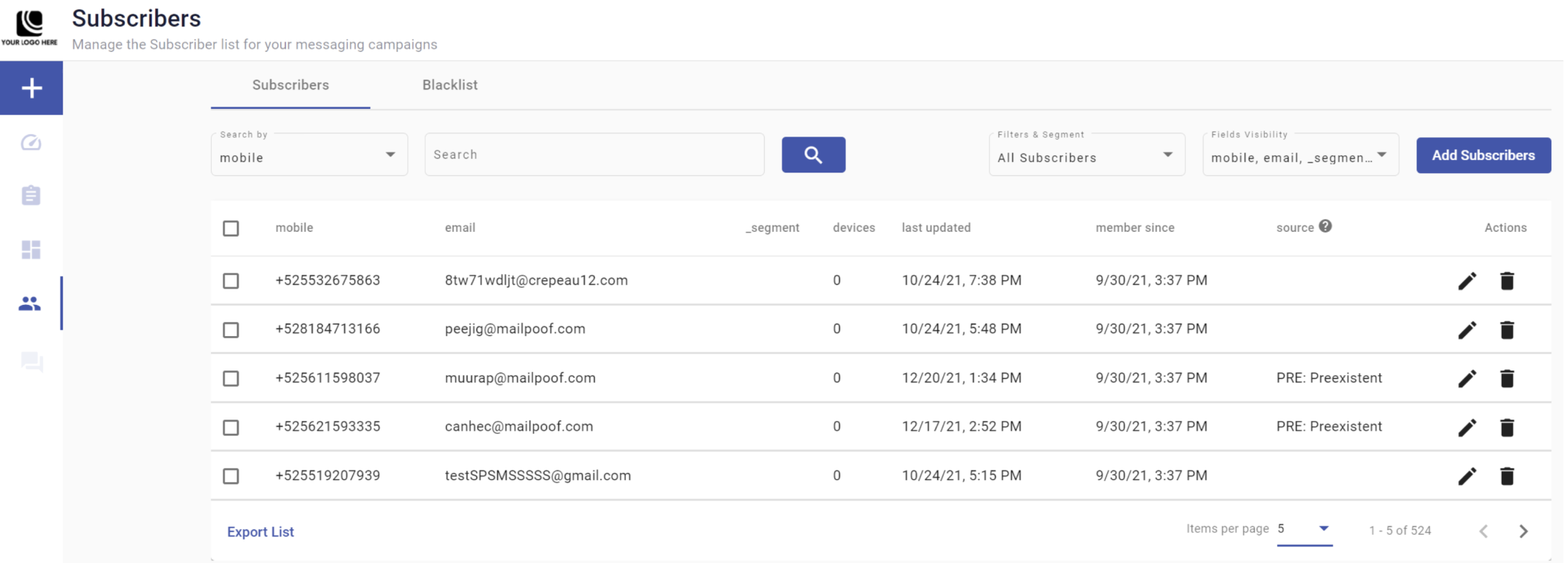
Editing Subscribers and Interactions
To edit a Subscriber data field, click on the Edit icon located under the Actions column for the subscriber you are interested in. The platform will expand the subscriber immediately underneath it, exposing all of its fields for modification.
Enter the new data in the field or fields that need modification and select Save. A message will be displayed confirming that the Subscriber information has been updated. This modification action will be reflected in the historical data stored for the subscriber.
At the very bottom of the expanded subscribers’ fields is a section that displays the last activity associated with the subscriber, be it management, broadcast or campaign related.
The platform provides you the option to view a historical of the subscribers’ related activities that you can access to by selecting View more interactions.
Delete Subscribers
If you select the Delete icon, a confirmation Dialog will be displayed to confirm the deletion of the Subscriber you have selected.

Click on Delete and a confirmation message will appear that the Subscriber has been deleted.
To Edit or Delete more than one Subscriber at a time, select the checkboxes for each Subscriber you want to Edit or Delete.
Once the Subscribers have been selected, the following options will be displayed at the top of the Subscriber List:
Edit:
To edit the subscribers you have selected, click on the Edit icon. Once selected, a Dialog box will be displayed.
The steps to edit bulk subscribers are the following:
- Select the Subscriber Field you want to modify for the selected Subscribers from the Field dropdown.
- Enter the value to be set for that selected List Field and
- Select Save.
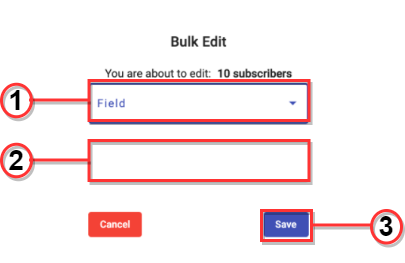
Delete : To delete the subscribers you have selected, click on the Delete icon.
Once Delete has been selected from the options, a Dialog box will be displayed.
The steps to delete bulk subscribers from the subscriber list are the following :
- Enter the number of Subscribers you have selected to Delete.
- Select Delete.

Once Delete is selected, a confirmation message will display at the bottom of the screen confirming the subscribers were deleted.
After the message disappears, the Total Number of Subscribers is updated in the Subscriber List.
Clear Selection : Click on the Clear Selection icon to uncheck each subscriber you have selected.
Search Subscribers
The Search bar allows you to search for a Subscriber by Fields. The search options are conditioned by the field shown in the Search bybox.
Search by is a Field’s dropdown menu that displays platform and user defined Fields. When a field is selected, it restricts the subscriber search to the data type associated with the field.
For example, if mobile is selected, the search will be restricted to numbers, partial or complete mobile phone numbers. Likewise, if a field has a text data type, as would the case for a name, alphanumeric characters could be used to do a search. The following is the current default Search by menu.

The fields last updated and member since within the menu, have a date data type and in consequence, the platform replaces the Search bar with a simplified version of the Show Date Range Filter, to facilitate date entry, as shown below.
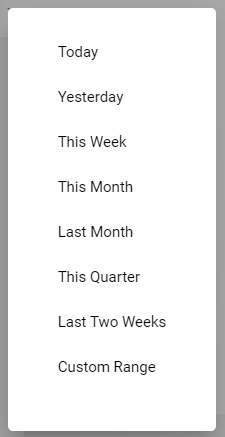
Selecting any of the date options, narrows the subscribers displayed to the selected date for either last updated or member since. You can also define a date data type field that suits your requirements and take advantage of this option.
Successful searches result in the corresponding output displayed.
Unsuccessful searches result in a blank screen. To return the global list, select the clear search icon to the right of the Search box.
If you want to return to the Subscribers list, click on the Clear icon located on the right side of the Search Subscriber bar.
Subscribers Source
The "Source" column indicates the origin from which campaign or method (by CSV or Manual) the user was added to the subscriber list.
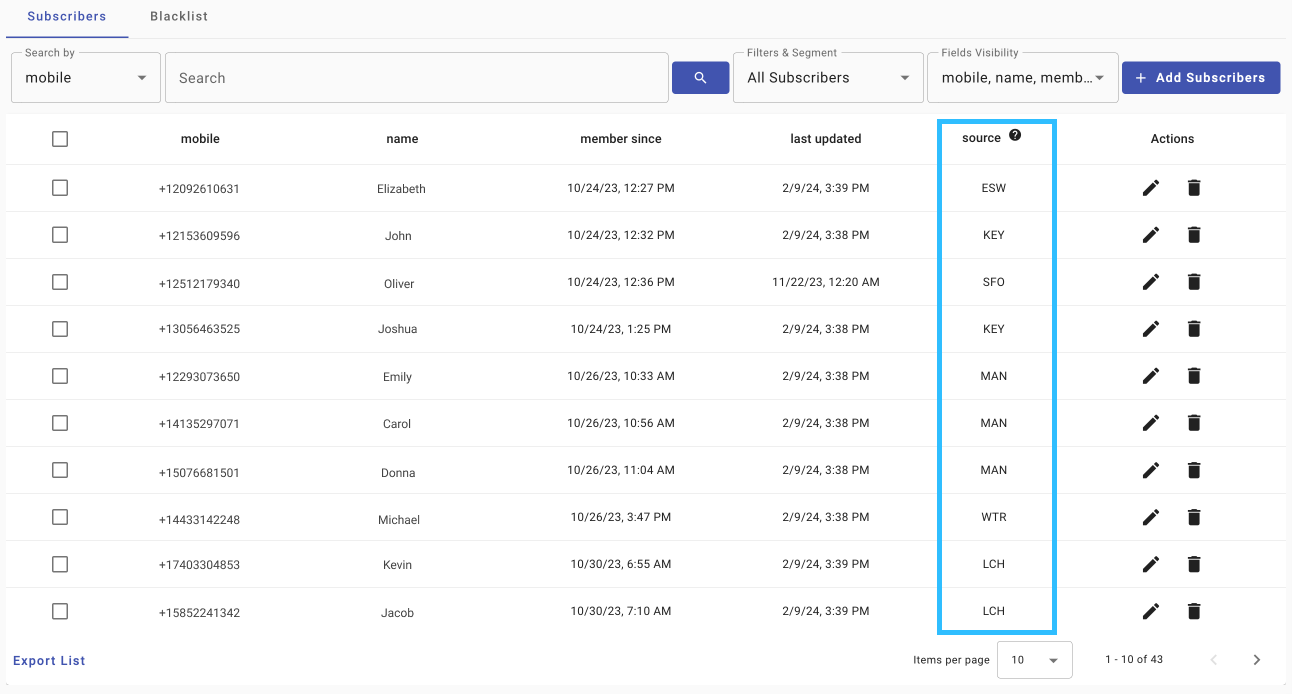
| Source Abbreviation | Source Name |
|---|---|
| CHA | Chatbot |
| CSV | Upload.csv |
| DCO | Digital Coupon |
| EMA | |
| ESW | E-swipe |
| GEO | Geofencing |
| KEY | Keyword |
| KWC | Keyword Campaign |
| LCH | Live Chat |
| MAN | Manual |
| PAS | Polls and Surveys |
| RGI | Raffle Giveaway |
| SFO | Subscription Form |
| SKC | SMS Keyword Campaign |
| SPS | SMS Polls and Surveys |
| STR | SMS Trivia |
| TRQ | Trivia Campaign |
| WPS | Web Polls and Surveys |
| WTR | Web Trivia |
Export Subscribers
Export a list of your subscribers and details with their respective information. This information includes each field added to the platform. For example : mobile number, email, name, among other fields. The list is exported as a CSV file which can easily be opened in Microsoft Excel for the creation of charts, pivots and other artifacts.
To export a Subscriber list:
To export a Subscriber list:
- Select Export List.
- Once selected, a Dialog will pop-up to export the subscribers list as a .csv file and send that list directly to the email associated with the current session.
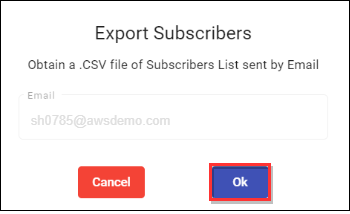
Pagination
The Subscriber List provides a very simple, but useful pagination to modify the amount of Subscribers that are displayed in the List.
You can choose to display either 5, 10, 25, 100 subscribers per page and view the total number of subscribers.
From the Subscribers section, click on the Items per page located in the lower-right corner of the List.
You can see next to the items per page, the total number of subscribers in the list.
When you select Items per page, a dropdown will open with the following options:
Each option corresponds to the number of Subscribers that will be displayed in the Subscriber List.
Filters
Use Filters to segment Subscribers based on set Rules placed on Subscriber List Fields.
The Filters allows Broadcasts to be delivered to a more tailored and specific set of Recipients based on Subscriber information.
By default, the Subscriber Table will be set to display All Subscribers without an added Filter.
From the main Subscribers section, click on the Filters & Segment dropdown and select the desired Filter.
Once a Filter has been selected, the Subscriber List will display those Subscribers that belong to that FIlter.
Create a new Filter
To start the creation of a new Filter, click on the Manage Segments or Filters option located in the Filters & Segment dropdown.
In this section, you can create, review and edit your list segmentation filters.
From the Manage Filters section, select the New Filter + button.
A Dialog will open to start the Filter creation process.
The steps to create a new Filter are the following:
-
Enter the Filter’s Name.
-
Add Filter Rules by clicking on the Create ( + ) button. It will display the following columns:
- List Field : Select the Subscriber List Field to apply the Filter Rule on
- Operation : Conditional Rule to be applied on the selected Column List Field.
- Value : Enter the value that will determine what the Filter Conditional Rule applies to.
- Once you have set the Filter Rules, click on the Save button to finish creating the new Filter.
NOTEYou may apply more than one Rule per Filter.
From the Manage Filters section, edit or delete an existing Filter by clicking on the Edit or Delete icons located in the Filter’s row.
If you chose Edit, once the changes have been made, click on Save.
To delete an existing Filter click on the Delete icon in the Actions column of the filter row. A Dialog will be displayed to confirm the Deletion of the Filter. Click on the Delete button to remove the filter.

Once Delete is clicked, the filter is removed from the Manage Filters section.
Example
Create a Filter to determine Subscribers that became ‘members’ after February 1, 2020.
This will be used in a Broadcast to deliver a special ‘Welcome’ SMS message to new Members.
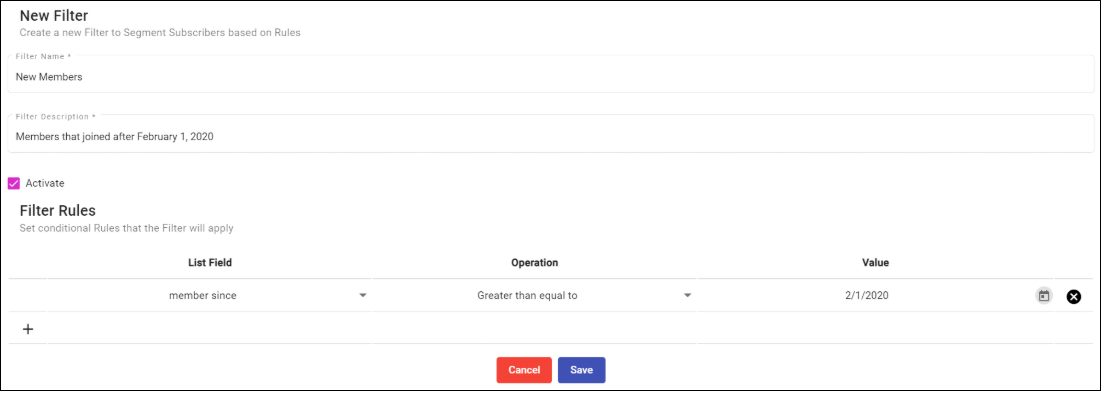
In the Filter Rules section, under the List Field select member since from to filter the Subscriber Field that contains the date where the Subscriber became a ‘member’.
In the Operation column, select Greater than equal to to obtain those that became members on or after February 1, 2020.
In the Value column select February 1, 2020 from the date picker.
Segments
Use Segments to segment subscribers by lists. That is, you can create a segmentation list that will contain subscribers.
By default, the Subscriber Table will be set to display All Subscribers without an added Segment.
From the main Subscribers section, click on the Filters & Segment dropdown and select the desired Segment.
Once a Segment has been selected, the Subscriber List will display those Subscribers that belong to that Segment.
Create a new Segment
To start the creation of a new Segment, click on the Manage Segments or Filters option located next to the Filters & Segment dropdown.
In this section, you can create, review and edit your Segmentation List.
From the Manage Segments section, select the New Segment + button.
A Dialog will open to start the Segment creation process.
The steps to create a new Segment are the following:
-
Enter the Segment’s Name.
-
Upload a CSV File containing a list of subscribers in segment by selecting the Browse Files button.
When the CSV file has been uploaded, you need to define the Column from the uploaded File that contains the mobile, email or name of the subscriber. It will display the following columns:
- Uploaded List Field: Select the Subscriber List Field to apply the Segment Rule on
-
Key Field: Select the key field that will allow you to segment the subscribers list depending on the selected key field(mobile, email or name).
Once the key field has been selected, it will automatically detect the following information for the Subscribers in the uploaded CSV file:
Number of Rows that have a valid Key Field (mobile, email or name) (Green-Box).
Number of Rows that have an invalid Key Field (mobile, email or name) (Red-Box).
Number of Rows that have an empty Key Field (mobile, email or name) (Gray-Box).
- Click on the Save button to finish creating the new Segment.
From the Manage Segments section, edit or delete an existing Segment by clicking on the Edit or Delete icons located in the Segment’s row.
If you chose Edit, once the changes have been made, click on Save.
To delete an existing Segment click on the Delete icon in the Actions column of the filter row. A Dialog will be displayed to confirm the Deletion of the Filter. Click on the Delete button to remove the Segment.
Once Delete is clicked, the segment is removed from the Manage Segments section.
Fields
The Subscribers table is made up of individual subscriber records that contain the Subscriber’s information on the platform.
“Out of the box”, the platform has no subscribers. This is, you have not added any subscribers to it. Furthermore, the platform has a predefined subscriber configuration which is the bare bones minimal subscriber configuration possible, that consists of the following elements:
- mobile: a valid phone number conforming to E.164, essentially consisting of
country code + area code + phone number. (user defined) - email: a valid email address (user defined)
- devices: identifies the device type associated with the subscriber (platform defined)
- member since: date when the subscriber was added to the platform (platform defined)
last updated: date of the last modification done to the subscriber (platform defined) - source: how the subscriber got added to the platform (platform defined)
These elements of the subscriber configuration are handled as subscriber fields or Fields, and together they make up the default subscriber configuration of the platform. You can visualize the basic configuration of a platform subscriber being as follows,

From the main Subscribers section, you are able to:
-
Select the Fields Visibility
-
Manage Fields - add, edit, or delete a Field
-
Edit or Delete List Fields
To configure the fields you want to display on the Subscriber table, click on the Fields Visibility dropdown,
Once selected, check the Fields that you want to display in the Subscriber table.
As mentioned above, the Basic Platform Subscriber configuration source Field, contains the information of how the subscriber was added to the platform. And when it is displayed on the table, it provides a tool tip with the key for identifying how the subscriber was added to the Subscribers List. The meaning of the abbreviations used is,
- SFO – Subscription Form
- KEY – Keyword
- CSV – Upload CSV
- MAN – Manual
- RGI – Raffle Giveaway
- WTR – Web Trivia
- SKC – SMS Keyword Campaign
- STR – SMS Trivia
- SPS – SMS Polls and Surveys
- GEO – Geofencing
- ESW – E-swipe
- DCO – Digital Coupon
- EMA – Email
An example of this is reflected in the table below.
In it, the first two subscribers’ entries were added from a CSV file named us-500 Name phone email.csv, which is shown in the table as such, while the third entry shows its source as MAN, meaning it was entered manually.
To manage the Subscriber Fields, select the Fields Visibility dropdown and click on the Manage Fields option.
Once selected, you will be redirected to the Field Management Section that allows you to review, add, edit and delete the fields associated with each subscriber record.
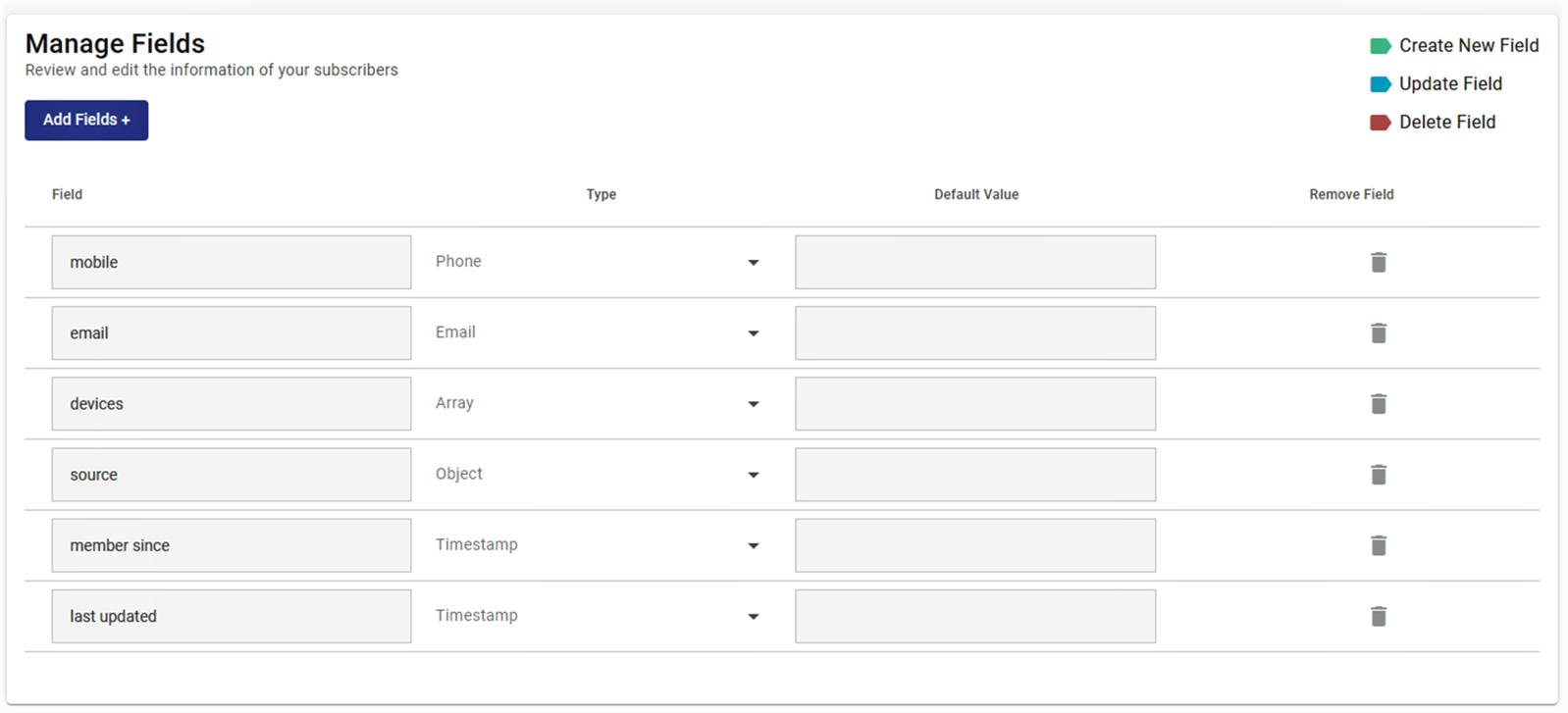
Add a new Field
From the Field Management screen, add a new Field by selecting the Add field +.
Once selected, a new row will be added to the table with the following fields:
-
Column - n: a placeholder for introducing the Field name that will be displayed.
-
Field Type: select an option from the dropdown to define the data type the new Field will contain.
-
Default Value: enter what the Field will contain as default.
-
Remove Field : Delete an existing field.
From the Field Management screen, edit and modify an existing Field’s Name, type or Default Value.
Once you have made the desired changes to the existing Fields, click Save.
If you want to delete an existing field, select the Delete icon located in the Field´s row.
Once you have clicked on the Delete icon next to the desired Field you wish to delete, click Save.
Updated 3 months ago
